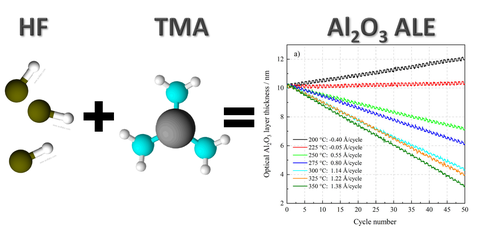25.04.2022
In situ studies on atomic layer etching of aluminum oxide using sequential reactions with trimethylaluminum and hydrogen fluoride

ALE of Al2O3
Johanna Reif, Martin Knaut, Sebastian Killge, Matthias Albert, Thomas Mikolajick, Johann W. Bartha
Controlled thin film etching is essential for future semiconductor devices, especially with complex high aspect ratio structures. Therefore, self-limiting atomic layer etching processes are of great interest to the semiconductor industry. In this work, a process for atomic layer etching of aluminum oxide (Al2O3) films using sequential and self-limiting thermal reactions with trimethylaluminum and hydrogen fluoride as reactants was demonstrated.
The Al2O3 films were grown by atomic layer deposition using trimethylaluminum and water. The cycle-by-cycle etching was monitored throughout the entire atomic layer etching process time using in situ and in real-time spectroscopic ellipsometry. The studies revealed that the sequential surface reactions were self-limiting versus reactant exposure. Spectroscopic ellipsometry analysis also confirmed the linear removal of Al2O3. Various process pressures ranging from 50 Pa to 200 Pa were employed for the Al2O3 etching. The Al2O3 etch rates increased with process pressures: Al2O3 etch rates of 0.92, 1.14, 1.22, and 1.31 Å/cycle were obtained at 300°C for process pressures of 50, 100, 150, and 200 Pa, respectively. The Al2O3 etch rates increased with the temperature from 0.55 Å/cycle at 250°C to 1.38 Å/cycle at 350°C. Furthermore, this paper examined the temperature dependence of the rivalry between the removal (Al2O3 etching) and growth (AlF3 deposition) processes using the reactants trimethylaluminum and hydrogen fluoride. The authors determined that 225°C is the transition temperature between AlF3 atomic layer deposition and Al2O3 atomic layer etching. The high sensitivity of in vacuo X-ray photoelectron spectroscopy allowed the investigation of the interface reactions for a single etching pulse as well as the initial etch mechanism. The Xray photoelectron spectroscopy measurements indicated that the fluorinated layer is not completely removed after each trimethylaluminum exposure. The Al2O3 atomic layer etching process mechanism may also be applicable to etch other materials such as HfO2.
Link zum Paper: https://avs.scitation.org/doi/full/10.1116/6.0001630
